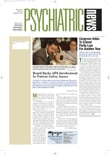There has been a dramatic rise in the number of Canadians using antidepressant medications since the mid-1990s.
So reported Scott Patten, M.D., Ph.D., an associate professor of psychiatry at the University of Calgary, at the annual meeting of the Canadian Psychiatric Association in Banff, Alberta, in November.
Back in 1994, the Canadian government launched the National Population Health Survey. A short, structured interview was given to some 18,000 Canadians about their health. Follow-up interviews were conducted in 1996, 1998, and 2000 and are expected to continue until 2016. Since the interviews also included some questions about medications that Canadians were using, the survey gives some interesting insights into antidepressant use by Canadians from 1994 to 2000 (the period for which the latest survey results are available).
For example, there has been a dramatic increase in the number of Canadians using antidepressants—actually a doubling—between 1994 and 2000.
If findings are broken down by gender, in 1994 only 5 percent of male Canadians with an episode of major depression in the preceding year were using antidepressants, versus 15 percent for female Canadians. By 2000, however, 25 percent of male Canadians with an episode in the preceding year were using them, versus 35 percent for female Canadians.
Some 5 percent of Canadians with an episode of major depression in the prior year aged 15 to 24 years were using antidepressants in 1994. The figure was 30 percent by 2000.
Only 3 percent of Canadians who were taking antidepressants were simultaneously using more than one antidepressant in 1994; it was up to 9 percent by 2000.
Why has there been such an upsurge in antidepressant use by Canadians since the mid-1990s? “The rate with which people consulted with health professionals did not change during this interval,” Pattern told Psychiatric News. “Therefore, our conclusion is that the increased use of antidepressants represents a change in physician behavior. They are either more likely to diagnose major depression or more likely to use medications when treating it.”
Puten stated that this marked increase in antidepressant use appears to have made a dent in the prevalence of depression among Canadians. The reason to think that it might have, he explained, is that results from the survey show that while the one-year prevalence rate of major depression among Canadians in 1994 was 6 percent, it was under 5 percent by 2000. ▪
